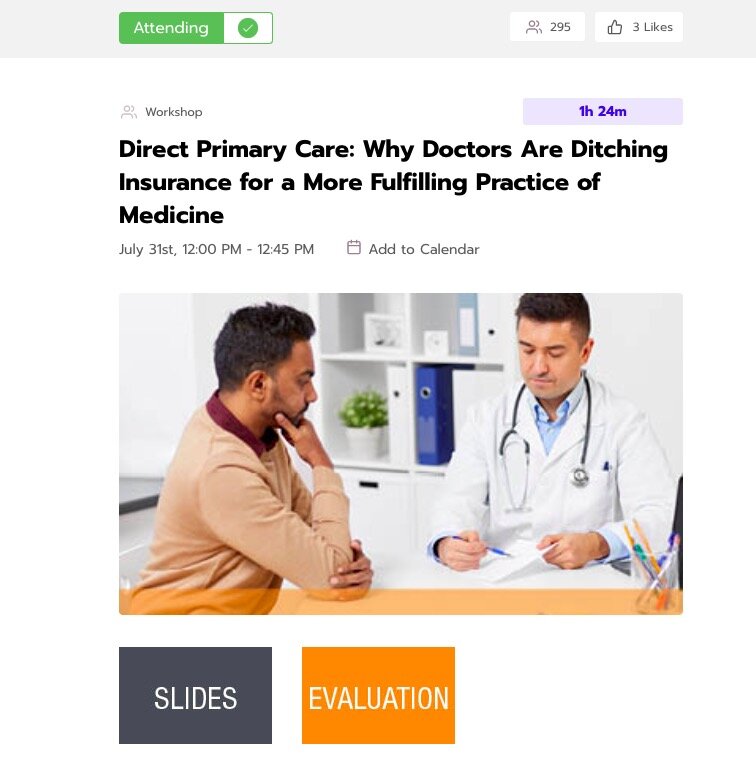1.) What is Direct Primary Care?
Direct primary care uses a membership model to deliver health care services directly to patients. Direct primary care (DPC) doctors don’t bill or use insurance. Rather, patients pay a monthly membership of $50 to $100 to receive primary care services directly from a board-certified family medicine physician or other primary care specialist.
2.) Why are primary care doctors choosing direct primary care over fee-for-service medicine?
Fee-for-service medicine often comes with a lot of unnecessary stress - there are so many prior authorizations and billing headaches, and doctors have to see more and more patients in less and less time. Doctors feel like they are losing their autonomy in these fee-for-service or insurance-based health care delivery models. Direct primary care offers a great alternative health care model to the typical fee-for-service set up. In the DPC model, doctors have more autonomy and they are able to have more time with each patient.
3.) How many patients do DPC doctors have in their panel?
Most DPC doctors have about 400 to 700 patients in their panel. This is in stark contrast to fee-for-service doctors who are mandated to see about 2,500 in their panel. I say mandate because fee-for-service doctors are often employed and they are told to see 25 to 30 patients each day, which translates to 18 to 20 minutes per patient visit.
4.) How many patients do DPC doctors see each day?
Direct primary care doctors see about 5 to 10 patients each day. Typically, family physicians see 1% of their panel each day. DPC doctors have about 500 patients in their panel, so they see about 5 patients each day. This allows doctors in the DPC model to have about 1 hour with each patient.
5.) What is the value for a community member who wants to sign up for a DPC practice?
People sign up for direct primary care practices because they can see their doctor when and for as much time as they need to. Doctors typically guarantee same-day or next-day appointments, which makes seeing the doctor convenient. People also choose DPC practices because they get clear communication with their doctor. DPC doctors often share their phone numbers and email addresses with patients.
6.) How many DPC doctors are practicing across the country?
When I first started my practice in 2016, there were roughly 300 direct primary care doctors practicing across the country. Now, there are about 1,500 direct primary care doctors practicing across the country. In context, there are roughly 133,000 family physicians in the United States, and that means about 1% of those doctors are engaging in the DPC model.
7.) How do you prescribe and dispense medications in a direct primary care practice?
Direct primary care doctors often buy medications at wholesale prices and then pass on those savings to their patients. We buy from a company called AndaMeds out of Florida, and this is the same wholesaler that supplies big box pharmacies. We use an inventory system in our EMR and then dispense those medications to our patients as needed.
8.) How do you get lab work done for your patients in a direct primary care practice?
We have a contract with Quest diagnostics in order to get lab work done for our patients in our direct primary care practice. We draw the blood in the office and then we send the labs to Quest (they pick it up from a box on the back of our office). We then get the results next day or up to 48 hours later for certain tests. We are able to save patients 50 to 90% on their lab costs.
9.) What about imaging services in direct primary care practices? How do patients get radiology services in direct primary care practices?
We contract with a local imaging center and our patients can go to this imaging center and save 50 to 90% on their imaging needs if they pay cash. For example, a chest x-ray of the anterior/posterior and lateral views is $45. An MRI of the knee is $300 with our local imaging center.
10.) Wow, this sounds like a great system! Why aren’t more doctors engaging in direct primary care medicine?
That’s a great question! The biggest barrier for typical doctors to start a direct primary care practice is fear. First, they don’t have any business training, so starting their own business is daunting. Second, they may not want to leave the steady paycheck of a large health care system and go out on their own. That’s why I’m here - to teach and inspire so more people feel comfortable and confident to take the leap!







